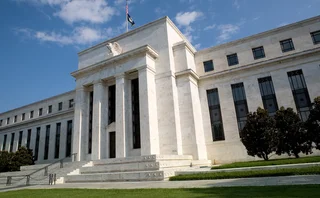
GFXC to entice buy-side code adoption with ESG tie-ups
Rating agency partnerships would link FX Global Code adoption to ESG scores

For years, one of the prime focuses of the Global Foreign Exchange Committee (GFXC) has been to encourage greater adoption of the FX Global Code among buy-side market participants. Since the code was updated in 2019, however, the GFXC’s success in this endeavour has been rather limited.
According to the committee’s official register, of the 1,162 financial firms that have signed the FX Global Code to date, 12% include asset managers, corporate treasuries, hedge funds, insurance companies, pension funds and sovereign wealth funds. This is a slight improvement on 2019 when just 9% of code signatories were from the buy side.
But for the majority of buy-side market participants there remains a reluctance to sign up, with many feeling that the code doesn’t fully apply to them. Others have suggested that a simpler version should be created for buy-side firms to help achieve greater adherence.
Nevertheless, the GFXC, under chair Andrea Maechler of the Swiss National Bank, has remained determined in its quest to boost acceptance from the buy side.
For instance, the committee is prototyping a web-based tool that would allow buy-side participants to identify which of the code’s principles apply to them – thereby lowering the barriers of entry to signing up. The tool is set to go live on the GFXC’s website later this year.
But a potential carrot that is currently being explored involves appealing to the buy side’s environmental, social and governance (ESG) concerns.
To accomplish this, the GFXC is looking at the possibility of partnering with ESG rating agencies – presumably the Sustainalytics and MSCIs of this world – so that anyone who signs the code can be recognised as having fulfilled the ‘G’ element of their ESG commitments. In theory, this would boost a buy-side firm’s overall ESG score if it became a signatory – something that trade bodies such as the Global Financial Markets Association have long lobbied for.
It could well prove an effective strategy for boosting buy-side adoption of the code of conduct given the capital markets' ever-growing focus on responsible investing. Many asset managers and institutions have already signed up to the United Nations' Principles for Responsible Investing, committing to incorporate ESG into their investment policies and practices. FX Global Code adherence could go a long way to meeting these targets.
According to the global head of FX sales at a European bank, the move could also help rebalance the market’s approach to ESG, in which the ‘E’ has tended to dominate conversations and transactions. Primarily, this is because environmental metrics, such as the amount of carbon dioxide a company emits, are easier to quantify and measure than those for governance, such as the extent to which women are included in corporate decision-making procedures.
However, there is a clear difference between signing the code and adhering to its principles in practice. It could be that firms sign up for an easy boost to their ESG score but then do little to implement the principles. So it will be interesting to see whether, or how, ongoing adherence to the code will be monitored in relation to a signatory’s ESG score.
While the GFXC has yet to comment publicly on such potential partnerships, it’s clear that any relationship between itself and an ESG rating agency could have benefits for the FX market: boosting buy-side code adoption and potentially increasing the FX market’s overall focus – and involvement – with ESG matters.
The latter certainly needs a push. The past two years, for example, have seen several banks enter ESG-linked FX hedges with asset managers and corporates, but these have mostly been one-off transactions. Real progress in this area is yet to be seen.
Only users who have a paid subscription or are part of a corporate subscription are able to print or copy content.
To access these options, along with all other subscription benefits, please contact info@risk.net or view our subscription options here: http://subscriptions.risk.net/subscribe
You are currently unable to print this content. Please contact info@risk.net to find out more.
You are currently unable to copy this content. Please contact info@risk.net to find out more.
Copyright Infopro Digital Limited. All rights reserved.
As outlined in our terms and conditions, https://www.infopro-digital.com/terms-and-conditions/subscriptions/ (point 2.4), printing is limited to a single copy.
If you would like to purchase additional rights please email info@risk.net
Copyright Infopro Digital Limited. All rights reserved.
You may share this content using our article tools. As outlined in our terms and conditions, https://www.infopro-digital.com/terms-and-conditions/subscriptions/ (clause 2.4), an Authorised User may only make one copy of the materials for their own personal use. You must also comply with the restrictions in clause 2.5.
If you would like to purchase additional rights please email info@risk.net
More on Our take
Thrown under the Omnibus: will GAR survive EU’s green rollback?
Green finance metric in limbo after suspension sees 90% of top EU banks forgo reporting
Has the Collins Amendment reached its endgame?
Scott Bessent wants to end the dual capital stack. How that would work in practice remains unclear
Talking Heads 2025: Who will buy Trump’s big, beautiful bonds?
Treasury issuance and hedge fund risks vex macro heavyweights
The AI explainability barrier is lowering
Improved and accessible tools can quickly make sense of complex models
Do BIS volumes soar past the trend?
FX market ADV has surged to $9.6 trillion in the latest triennial survey, but are these figures representative?
DFAST monoculture is its own test
Drop in frequency and scope of stress test disclosures makes it hard to monitor bank mimicry of Fed models
Lightening the RWA load in securitisations
Credit Agricole quants propose new method for achieving capital neutrality
How much do investors really care about Fed independence?
The answer for some is more nuanced than you might think







